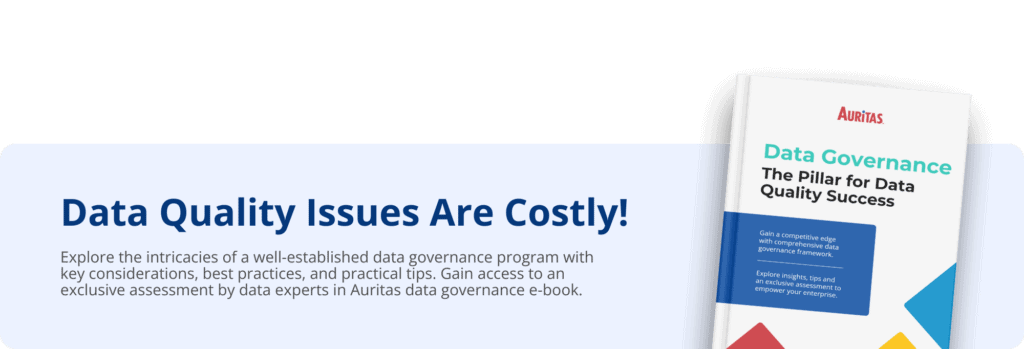In the digital age, data is a critical asset for large organizations. However, maximizing the full potential of the data requires placing a high emphasis on data quality. Implementing data governance enables organizations to define standards to enforce data quality controls, mitigating inconsistencies and inaccuracies that can hinder decision-making processes. Data governance empowers organizations to optimize operations, make informed decisions, and gain a competitive edge in the dynamic business landscape.
“Data Governance is a system of decision rights and accountabilities for information-related processes, executed according to agreed-upon models which describe who can take what actions with what information, and when, under what circumstances, using what methods.” – Data Governance Institute
To establish and execute a robust data governance strategy, it is essential to have a comprehensive grasp of the underlying data governance framework. While the specifics of these frameworks may differ based on unique organizational needs and industry regulations, they typically encompass several fundamental components crucial for effective governance. By familiarizing themselves with these, organizations can gain a solid foundation for implementing successful data governance practices tailored to their specific context.
The Data Governance Framework – Key Components
1.Objectives and Goals:
Objectives and goals serve as guiding principles and targets that organizations aim to achieve through effective data governance practices. These objectives typically revolve around ensuring and improving data quality, enhancing data security and privacy, and promoting regulatory compliance. By setting clear goals, organizations can align their data governance efforts with overarching business objectives.
What are some examples of goals?
- Establish a culture of data-driven decision-making and promote the value of data as a strategic asset.
- Enhance data privacy, security, and compliance with relevant regulations.
- Enable effective data sharing, integration, and interoperability.
- Improve data quality and establish data management best practices.
- Optimize data lifecycle management and data governance processes.
2. Policies and procedures
These are the foundational guidelines and principles that define how data should be managed and governed within the organization. They outline objectives, standards, and rules for a series of topics such as data quality, data integration, data privacy, data security, and compliance. Data governance policies serve as a foundation for aligning data practices with organizational objectives. They promote consistency in data handling and establish a framework for effective decision-making based on reliable and trusted data.
What are some examples of procedures organizations can implement?

- Data Classification Policy: Establishes guidelines for classifying data based on its sensitivity, criticality, and regulatory requirements.
- Data Quality Management Policy: Outlines procedures for data profiling, data validation, data cleansing, and data quality monitoring.
- Data Privacy and Security Policy: Defines requirements for data privacy, security controls, access management, encryption, and incident response.
- Metadata Management Policy: Specifies guidelines for capturing, documenting, and managing metadata to enable data understanding and lineage.
- Data Lifecycle Management Policy: Provides procedures for data creation, storage, retention, archival, and disposal.
- Compliance and Regulatory Policy: Ensures compliance with data protection.
3. Processes
Processes are the structured workflows and procedures that enable the implementation and execution of governance policies. Processes provide a systematic approach for managing and governing data throughout its lifecycle, from data capture and storage to data analysis and dissemination. They cover areas such as data classification, data stewardship, quality assessment, and data access and usage controls. Data governance processes ensure that data is consistently managed and utilized in accordance with established policies.
4. Roles and Responsibilities
This component defines the individuals and their accountabilities within an organization’s data governance framework. By clearly defining these, organizations can establish a structured approach to data governance, assign accountability, and foster a culture of data stewardship throughout the organization. Roles can include:
- Data stewards who are responsible for ensuring the quality, integrity, and proper use of specific data domains or sets.
- Data owners who have ultimate accountability for the data and its associated policies.
- Data custodians who manage the technical aspects of data storage, access, and security.
- Data governance committees that provide oversight and strategic direction for the program.
- Executive sponsors who champion the importance of governance and ensure its alignment with organizational goals.
5. Tools and Technologies
The governance frameworks may incorporate specific tools and technologies to support data management and governance activities. These enable organizations to automate and streamline data governance processes, enhance data visibility, ensure compliance, and enable efficient data management and decision-making. These tools can include:

- Data cataloging tools that provide a centralized inventory of data assets.
- Metadata management systems that capture and manage metadata related to data elements.
- Data quality tools that assess and monitor data quality.
- Data lineage tools that track the origin and transformations of data.
- Data access and security controls that enforce access policies and protect sensitive data.
6. Communication and Training
Effective communication and training are essential for promoting awareness and fostering a culture of data stewardship within the organization. Training programs aim to educate employees on their roles and responsibilities within the data governance framework and impart knowledge about data management best practices. These communication and training initiatives foster a shared understanding and empower employees to contribute to the success of data governance initiatives. What are some examples of that?
- Training Workshops: Conducting interactive workshops to educate employees about governance principles, policies, and procedures. These workshops should provide practical guidance on how to implement these practices in their day-to-day work.
- Data Governance Champions: Identifying and training individuals within the organization who can serve as advocates and subject matter experts.
- Internal Webinars or Lunch & Learns: Organizing regular internal sessions where subject matter experts share insights and best practices related to data governance and their importance for the organization.
- Ongoing Communication Channels: Establishing ongoing communication channels, such as a newsletter, discussion forums, or online communities, where employees can stay updated on new initiatives, ask questions, and share experiences.
The Data Governance Institute has developed a well-established framework. It serves as a structure for classifying, organizing, and communicating the intricate activities associated with decision-making and action-taking concerning enterprise data. It acts as a guiding compass, empowering organizations to establish effective data governance practices, enhance data quality, ensure compliance, and drive valuable insights.

As organizations continue to grapple with increasing data volumes and complexities, embracing data governance becomes more vital than ever. It ensures the integrity, security, and reliability of data assets. Furthermore, it addresses regulatory compliance concerns, mitigates risks, and safeguards the trust of customers and stakeholders. By prioritizing data governance, organizations can take advantage of the true value of their data, foster a culture of data stewardship, and position themselves for long-term success in a data-centric world.
Now, use this knowledge to access your organization’s data governance practices. Download the data governance checklist prepared by Auritas’ experts and learn how you can improve your current practices.

